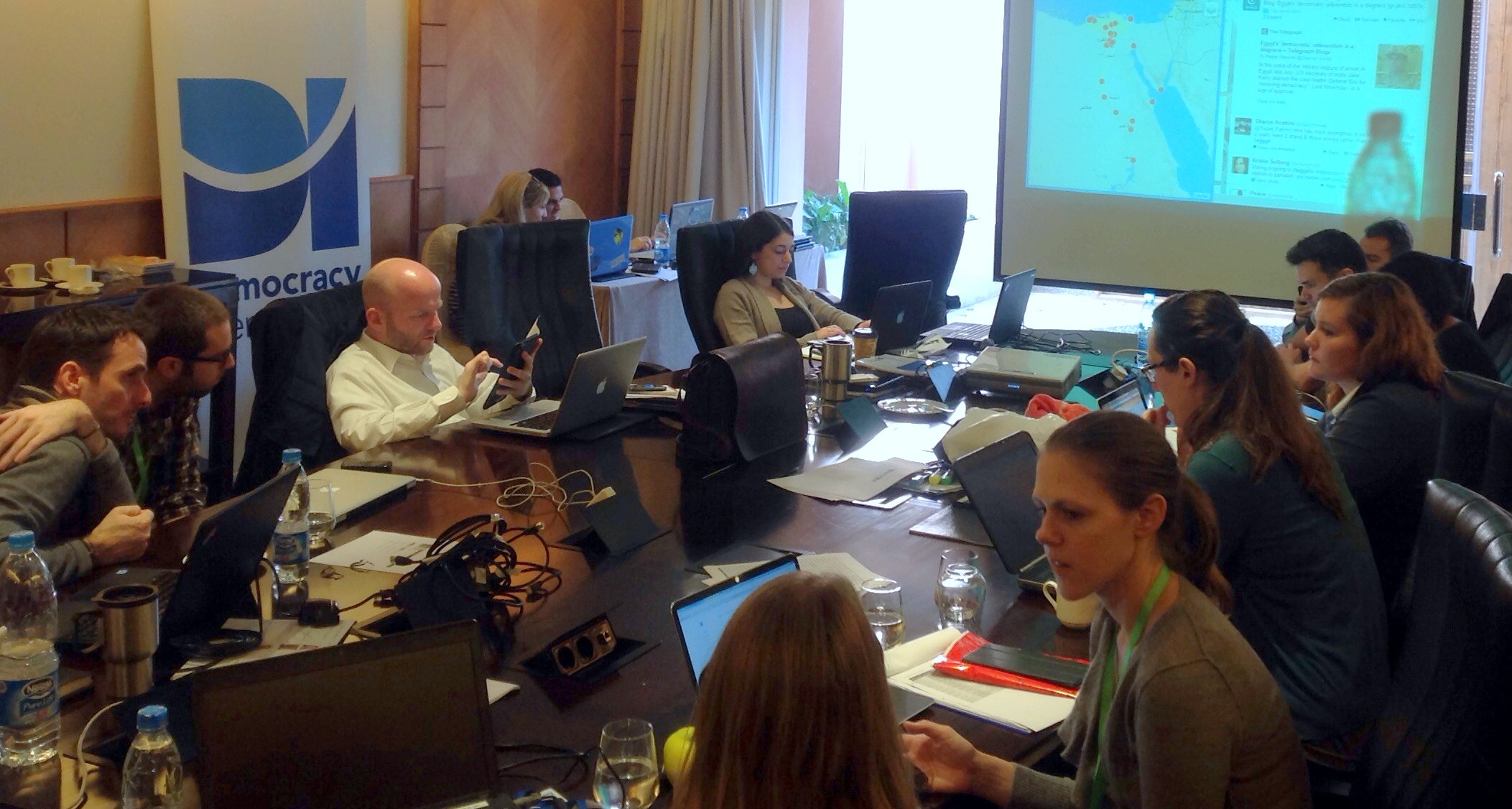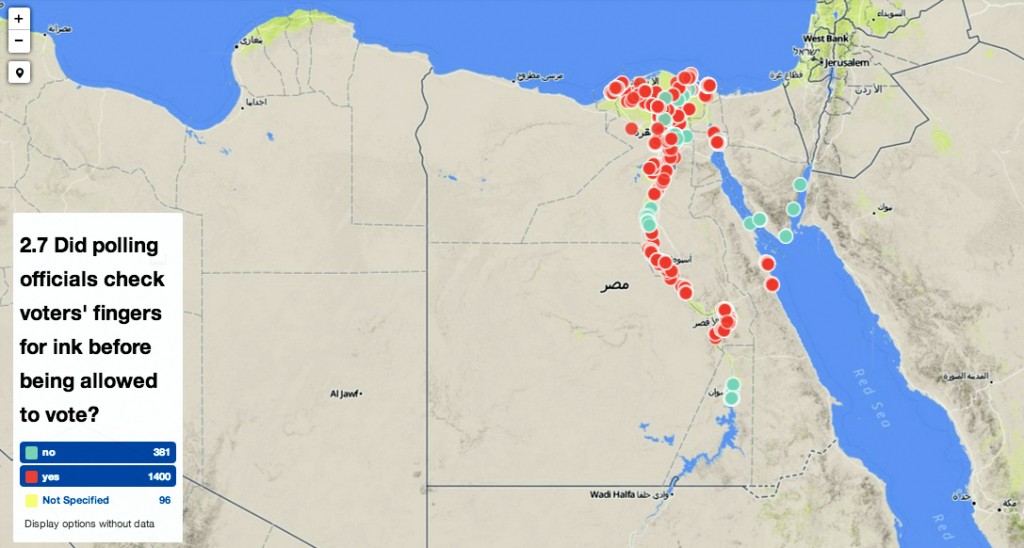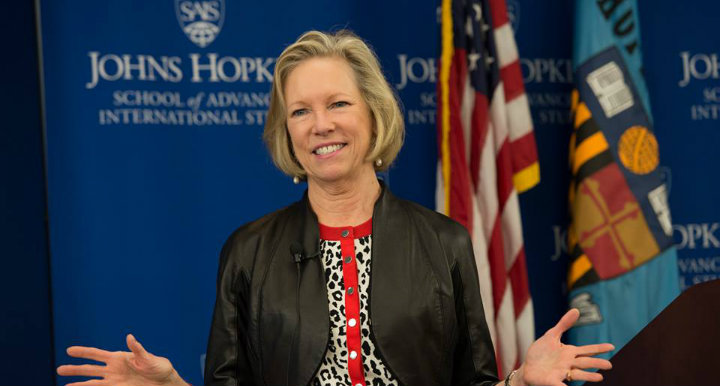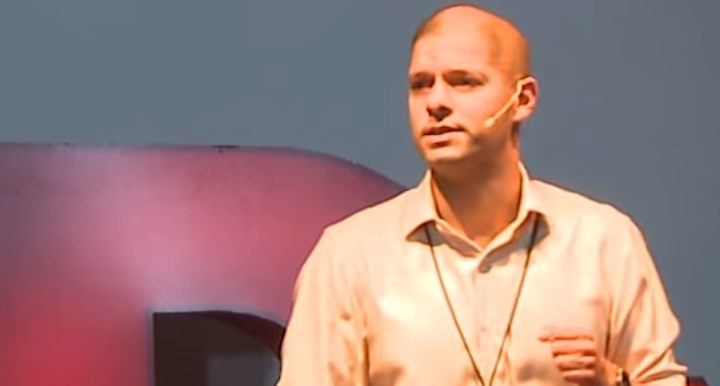How has the use of ICTs to collect election observation findings evolved over the past decade?
By Michael Baldassaro (@mbaldassaro), Innovation Director, Democracy International (@Democracyintl)
Over the past three decades, election observation conducted by independent international and domestic organizations has become a normative global practice. When conducted effectively, observation provides a check on the electoral process, promotes public confidence in the process to the degree warranted, detects and deters fraud, and offers recommendations to stakeholders to improve future elections. On Election Day, observers are deployed to polling stations to witness the voting process and fill out observation forms that are used by organizational leadership to issue statements about the quality of the process.
For its election observation mission to the 2014 Egypt Constitutional Referendum, Democracy International (DI) used Formhub, a free, open-source, cloud-based data collection and analysis toolkit. Developed by Columbia University’s Sustainable Engineering Lab, Formhub enables observers to send reports from polling stations via smartphone or tablet app. These findings are then aggregated and visualized in real-time using integrated open-source Mapbox software created by Development Seed.
Watch the CNN report on Democracy International using Formhub to observe in Egypt.
DI deployed 83 observers equipped with Google Nexus 7 tablets. An e-form was downloaded onto an app called ODK Collect and used to capture observer findings and GPS location data.[1] Observers transmitted the forms directly from polling centers to Formhub over the mobile data network with an incredible 100% success rate. By the end of the first day of voting, nearly 1,000 observation forms were submitted from polling stations and mapped on Formhub; by the end of the second day, more than 1,900 forms were collected and mapped (note: voting in Egypt takes place over a two-day period).
Because Formhub is a cloud-based server, logged in users were able to visit the Formhub website and see the data, graphs, and maps as they are updated in real-time. Users were also able to download all the data collected on to their laptops in human-readable (xls) and machine-readable (csv, kml) formats.
Beyond real-time collection and mapping of data, using Formhub enabled DI to improve the quality of the data as well:
- Observation forms were designed to improve quality control and error reduction by applying “skip logic” to bypass questions that were illogical based on answers to previous questions and “logic tests” to avoid the capture of illogical data that contradicted earlier responses;
- Using a smart device made it possible to not only capture GPS information, but to timestamp reports, providing knowledge of where and when violations occurred; and
- Notes, hits and reminders were incorporated into forms to provide observers with contextual information to reduce possible confusion and provide more accurate responses.
[Read how Formhub worked from an observer’s perspective in the field update by TechChange’s Christopher Neu] As a result of using Formhub to collect observer data, DI was able to analyze data much more quickly and accurately than ever before for the purposes of issuing a election observation statement. Given that the software was entirely free to download and use, the only costs incurred related to hardware procurement (tablets which will be used in future election observation missions in Egypt and beyond), SIM cards, and mobile airtime (for mobile data usage).
DI decided to use Formhub in Egypt because the country has a relatively robust and extensive mobile data network. In many countries, mobile data networks are often quite limited, i.e. confined to major urban areas, or practically non-existent. Where such infrastructure is lacking, the benefits of using a smart reporting system – as opposed to ubiquitous and familiar mobile, or even paper – are essentially negated.
A brief overview of the evolution of ICTs in Election Observation
A reliable internal communications system is critical to the success of any election observation mission. Organizations have historically relied on paper observation forms to gather data from observers in the field. Over the past decade, the increasing prevalence of familiar technology – notably the mobile (feature) phone – has made it possible to collect data quickly and efficiently, allowing organizations to make timely statements about the electoral process.
Using SMS to transmit observation data has become common practice – and almost essential in observation missions where hundreds or thousands of observers are deployed. Most SMS communications systems used in election observation employ a reporting method that uses strings of alphanumeric code (a1b2c1d3…) and converts them into human-readable findings. In recent years, tech start-ups such as Souktel, Telerivet, and TextIt have made the “old-fashioned” feature phone smarter, developing USSD (Unstructured Supplementary Service Data) and IVR (Interactive Voice Response) software that replaces messy strings of code with questions sent to feature phones via text- or voice-prompt systems[2].
With the increasing prevalence of smart devices, some organizations have begun using smartphone and tablet applications for collecting observation data. Relatively expensive hardware costs and weak telecommunications infrastructure in many countries precludes this from being a mainstream data collection method for the moment. However, free (or low-cost) open-source toolkits such as Formhub,Kobo Toolbox, and Open Data Kit (ODK) provide off-the-shelf, customizable solutions for organizations interested in piloting “smart” data capture methods. An early adopter of smart data collection, The Carter Center first deployed ODK for its 2012 Egyptian Presidential Election Observation Mission.
While Formhub is an excellent toolkit for organizations looking to collect data in real-time, it may not be the best tool for every observation mission everywhere in the world. At the end of the day, it’s important for an organization undertaking an observation mission to select the most appropriate communications system for the context. Technology is a like any other tool and selecting the most appropriate tool for the job is much more important than selecting the most sophisticated tool. Complexity and high cost are not good indicators of a good communications system. Mechanisms that provide speed, accuracy, quality, reliability, efficiency, and user-friendliness in data collection will always be the most appropriate.
[1]Formhub was built from the code base of another open-source data collection toolkit called Open Data Kit (ODK), developed by the University of Washington. Formhub was designed to work with the ODK data collection app: ODK Collect.
[2]Note: if you have ever responded to a mobile survey, you have encountered a USSD system; if you have ever called a number and got an automated answering service, you have interacted with an IVR system




